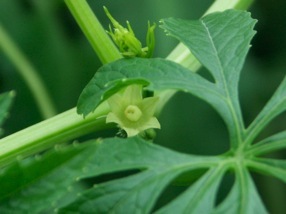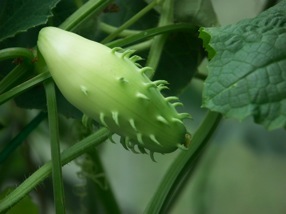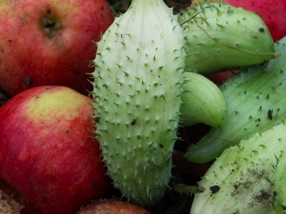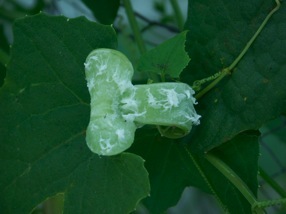
Cyclanthera
I don’t know what it is exactly, but I like all sorts of cyclantheras. Strange, because they’re not the tastiest vegetable in the world (I didn’t say they’re bad either!), nutritional value probably isn’t really high. It could be their appaerance, but some other vegetables (momordica or jelly cucumber relatives for instance) have this as well, and I’m not that fond growing these. Maybe it’s the easy way they are grown out, or maybe some other strange unknown affection I have with them...


Recently I received a packet of a cyclanthera variety from Colombia, strangely enough these seem to be called pepino over there, while in other parts of Latin America and the rest of the world, pepino is known as a whole other plant .
I’m slowly but staedily beginning to see an imaginative picture of hundreds of cyclanthera forms, and especially sizes, my friend Jean-Luc grew out a huge one, possibly up to 20 cms. My biggest reach maybe 12-13 cms, but that’s fine. I don’t really feed the plants, and let the fruits hang for a long time, so they possibly don’t have the energy to reach full size.
The only cyclanthera that has gained a bit of attention is lady’s slipper (cyclanthera pedata), the spineless fruit in the picture above left. I don’t see why it has become more popular compared to other cyclanthera varieties, except for this spineless appaerance. Over here other varieties are easier to grow out, and certainly more productive.


The plants can be invasive, some can overtake parts of the garden when they like it. Don’t place them in a greenhouse, unless you’re convinced you have a variety that isn’t really capable of overgrowing half of the house. Outside they’re more controllable, they reach some 2 metres (depending on variety), and are happy with some support of fine branches, which they will soon overgrow (see picture).
Some varieties are still daylength-sensitive, so they will only flower when days are shorter than 12 hours. If you bring a variety from South America, don’t be amazed it doesn’t produce any fruits during summer, it could well be one of these daylength-sensitive ones.
A very peculiar one is a wild form, the exploding cucumber (possibly cyclanthera explodens), grow it for ornament only, because taste isn’t really good, and watch it shoot out the seeds when the pods are ripe. But be careful, protect your eyes!


Some varieties are better for eating than others, I like the ‘achocca fat baby’ (cyclanthera brachystachya) and a big-fruited one (see picture, no, the apples aren’t small sized, but not really huge either), that can be easily split and filled up with all sorts of goodies and placed in the oven). I do think however that some work can be done to improve their taste.